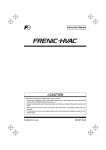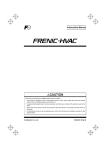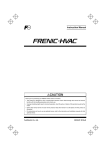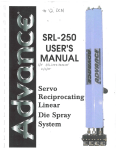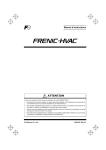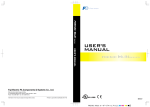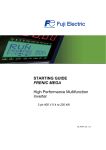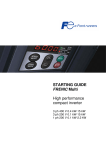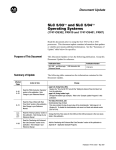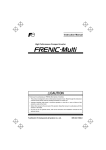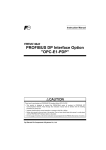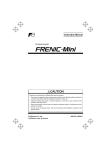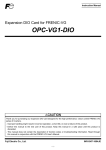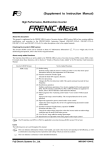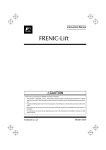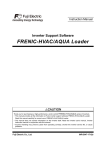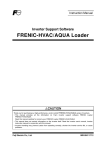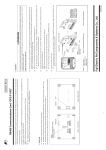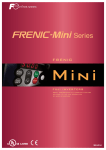Download Instruction Manual
Transcript
Instruction Manual Thank you for purchasing our FRENIC-HVAC series of inverters. • This product is designed to drive a three-phase induction motor. Read through this manual to become familiar with the handling procedure and correct use. • Improper handling might result in incorrect operation, short life cycle, or failure of this product as well as the motor. • Deliver this manual to the end user of this product. Keep this manual in a safe place until this product is discarded. • For instructions on how to use an optional device, refer to the instruction and installation manuals for that optional device. Fuji Electric Co., Ltd. INR-SI47-1610-E Copyright © 2012 Fuji Electric Co., Ltd. All rights reserved. No part of this publication may be reproduced or copied without prior written permission from Fuji Electric Co., Ltd. All products and company names mentioned in this manual are trademarks or registered trademarks of their respective holders. The information contained herein is subject to change without prior notice for improvement. Preface Thank you for purchasing our FRENIC-HVAC series of inverters. This product is designed to drive a three-phase induction motor. This instruction manual provides only minimum requisite information for wiring and operation of the product. Read through this manual before use. For details about this product, refer to the FRENIC-HVAC User's Manual that contains the precautions, detailed functions and specifications, wiring, configuration and maintenance. Related documentation - FRENIC-HVAC User's Manual These materials are subject to change without notice. Be sure to obtain the latest editions for use. Safety precautions Read this manual thoroughly before proceeding with installation, connections (wiring), operation, or maintenance and inspection. Ensure you have sound knowledge of the device and familiarize yourself with all safety information and precautions before proceeding to operate the inverter. Safety precautions are classified into the following two categories in this manual. Failure to heed the information indicated by this symbol may lead to dangerous conditions, possibly resulting in death or serious bodily injuries. Failure to heed the information indicated by this symbol may lead to dangerous conditions, possibly resulting in minor or light bodily injuries and/or substantial property damage. Failure to heed the information contained under the CAUTION title can also result in serious consequences. These safety precautions are of utmost importance and must be observed at all times. Application • This product is designed to drive a three-phase induction motor. Do not use it for single-phase motors or for other purposes. Fire or an accident could occur. • This product may not be used for a life-support system or other purposes directly related to the human safety. • Though the product is manufactured under strict quality control, install safety devices for applications where serious accidents or property damages are foreseen in relation to the failure of it. An accident could occur. Installation • Install the inverter on a base made of metal or other non-flammable material. Otherwise, a fire could occur. • Do not place flammable object nearby. Doing so could cause fire. i • Do not support the inverter by its front cover during transportation. Doing so could cause a drop of the inverter and injuries. • Prevent lint, paper fibers, sawdust, dust, metallic chips, or other foreign materials from getting into the inverter or from accumulating on the heat sink. • When changing the positions of the top and bottom mounting bases, use only the specified screws. Otherwise, a fire or an accident might result. • Do not install or operate an inverter that is damaged or lacking parts. Doing so could cause fire, an accident or injuries. Wiring • If no zero-phase current (earth leakage current) detective device such as a ground-fault relay is installed in the upstream power supply line in order to avoid the entire power supply system's shutdown undesirable to factory operation, install a residual-current-operated protective device (RCD)/earth leakage circuit breaker (ELCB) individually to inverters to break the individual inverter power supply lines only. Otherwise, a fire could occur. • When wiring the inverter to the power source, insert a recommended molded case circuit breaker (MCCB) or residual-current-operated protective device (RCD)/earth leakage circuit breaker (ELCB) (with overcurrent protection) in the path of each pair of power lines to inverters. Use the recommended devices within the recommended current capacity. • Use wires in the specified size. • Tighten terminals with specified torque. Otherwise, a fire could occur. • When there is more than one combination of an inverter and motor, do not use a multicore cable for the purpose of handling their wirings together. • Do not connect a surge killer to the inverter's output (secondary) circuit. Doing so could cause a fire. • Be sure to ground the inverter's grounding terminals G. Otherwise, an electric shock or a fire could occur. • Qualified electricians should carry out wiring. • Be sure to perform wiring after turning the power OFF. Otherwise, an electric shock could occur. • Be sure to perform wiring after installing the inverter unit. Otherwise, an electric shock or injuries could occur. • Ensure that the number of input phases and the rated voltage of the product match the number of phases and the voltage of the AC power supply to which the product is to be connected. • When using this product in combination with a PWM converter, refer to the instructions given in the FRENIC-HVAC User's Manual. Otherwise, a fire or an accident could occur. • Do not connect the power supply wires to the inverter output terminals (U, V, and W). Doing so could cause fire or an accident. ii • In general, sheaths of the control signal wires are not specifically designed to withstand a high voltage (i.e., reinforced insulation is not applied). Therefore, if a control signal wire comes into direct contact with a live conductor of the main circuit, the insulation of the sheath might break down, which would expose the signal wire to a high voltage of the main circuit. Make sure that the control signal wires will not come into contact with live conductors of the main circuit. Doing so could cause an accident or an electric shock. • Before changing the switches, turn OFF the power and wait at least 10 minutes. Make sure that the charging lamp is turned OFF. Further, make sure, using a multimeter or a similar instrument, that the DC link bus voltage between the terminals P(+) and N(-) has dropped to the safe level (+25 VDC or below). Otherwise, an electric shock could occur. • The inverter, motor and wiring generate electric noise. Be careful about malfunction of the nearby sensors and devices. To prevent them from malfunctioning, implement noise control measures. Otherwise an accident could occur. • The leakage current of the EMC filter built-in type of inverters is comparatively large. Be sure to perform protective grounding. Otherwise, an accident or an electric shock could occur. Operation • Be sure to mount the front cover before turning the power ON. Do not remove the cover when the inverter power is ON. Otherwise, an electric shock could occur. • Do not operate switches with wet hands. Doing so could cause electric shock. • If the auto-reset function has been selected, the inverter may automatically restart and drive the motor depending on the cause of tripping. Design the machinery or equipment so that human safety is ensured at the time of restarting. Otherwise, an accident could occur. • If the stall prevention function (current limiter), automatic deceleration (anti-regenerative control), or overload prevention control has been selected, the inverter may operate with acceleration/deceleration or frequency different from the commanded ones. Design the machine so that safety is ensured even in such cases. key on the keypad is effective only when the keypad operation is enabled with function code • The F02 (= 0, 2 or 3). When the keypad operation is disabled, prepare an emergency stop switch separately for safe operations. Switching the run command source from keypad (local) to external equipment (remote) by turning ON the "Enable communications link" command LE disables the key. To enable the key for an emergency stop, select the STOP key priority with function code H96 (= 1 or 3). • If any of the protective functions have been activated, first remove the cause. Then, after checking that the all run commands are set to OFF, release the alarm. If the alarm is released while any run commands are set to ON, the inverter may supply the power to the motor, running the motor. Otherwise, an accident could occur. iii • If you enable the "Restart mode after momentary power failure" (Function code F14 = 3 to 5), then the inverter automatically restarts running the motor when the power is recovered. Design the machinery or equipment so that human safety is ensured after restarting. • If the user configures the function codes wrongly without completely understanding this Instruction Manual and the FRENIC-HVAC User's Manual, the motor may rotate with a torque or at a speed not permitted for the machine. An accident or injuries could occur. • Even if the inverter has interrupted power to the motor, if the voltage is applied to the main circuit input terminals L1/R, L2/S and L3/T, voltage may be output to inverter output terminals U, V, and W. • Even if the motor is stopped due to DC braking, voltage is output to inverter output terminals U, V, and W. An electric shock may occur. • The inverter can easily accept high-speed operation. When changing the speed setting, carefully check the specifications of motors or equipment beforehand. Otherwise, injuries could occur. • Do not touch the heat sink because it becomes very hot. Doing so could cause burns. • The DC brake function of the inverter does not provide any holding mechanism. Injuries could occur. • Ensure safety before modifying the function code settings. Run commands (e.g., "Run forward" FWD, "Force to run" FMS), stop commands (e.g., "Coast to a stop" BX), and frequency change commands can be assigned to digital input terminals. Depending upon the assignment states of those terminals, modifying the function code setting may cause a sudden motor start or an abrupt change in speed. • When the inverter is controlled with the digital input signals, switching run or frequency command sources with the related terminal commands (e.g., SS1, SS2, SS4, SS8, Hz2/Hz1, Hz/PID, IVS, LE and FMS) may cause a sudden motor start or an abrupt change in speed. • Ensure safety before modifying customizable logic related function code settings (U codes and related function codes) or turning ON the "Cancel customizable logic" terminal command CLC. Depending upon the settings, such modification or cancellation of the customizable logic may change the operation sequence to cause a sudden motor start or an unexpected motor operation. • If any abnormality is found in the inverter or motor, immediately stop it and perform troubleshooting, referring to the FRENIC-HVAC User's Manual. An accident or injuries could occur. iv Maintenance and inspection, and parts replacement • Before proceeding to maintenance or inspection, turn OFF the power and wait at least 10 minutes. Make sure that the charging lamp is turned OFF. Further, make sure, using a multimeter or a similar instrument, that the DC link bus voltage between the terminals P(+) and N(-) has dropped to the safe level (+25 VDC or below). Otherwise, an electric shock could occur. • Maintenance, inspection, and parts replacement should be made only by qualified persons. • Take off the watch, rings and other metallic objects before starting work. • Use insulated tools. Otherwise, an electric shock or injuries could occur. • Never modify the inverter. Doing so could cause an electric shock or injuries. Disposal • Treat the inverter as an industrial waste when disposing of it. Otherwise injuries could occur. GENERAL PRECAUTIONS Drawings in this manual may be illustrated without covers or safety shields for explanation of detail parts. Restore the covers and shields in the original state and observe the description in the manual before starting operation. Icons The following icons are used throughout this manual. This icon indicates information which, if not heeded, can result in the inverter not operating to full efficiency, as well as information concerning incorrect operations and settings which can result in accidents. This icon indicates information that can prove handy when performing certain settings or operations. This icon indicates a reference to more detailed information. v Conformity to the Low Voltage Directive in the EU If installed according to the guidelines given below, inverters marked with CE are considered as compliant with the Low Voltage Directive 2006/95/EC. Compliance with European Standards Adjustable speed electrical power drive systems (PDS). Part 5-1: Safety requirements. Electrical, thermal and energy. IEC/EN 61800-5-1: 2007 1. The ground terminal G should always be connected to the ground. Do not use only a residual-current-operated protective device (RCD)/earth leakage circuit breaker (ELCB)* as the sole method of electric shock protection. Be sure to use ground wires of recommended size listed on page vii. *With overcurrent protection. 2. To prevent the risk of hazardous accidents that could be caused by damage of the inverter, install the specified fuses in the supply side (primary side) according to the following tables. - Breaking capacity: Min. 10 kA - Rated voltage: Min. 500 V Nominal Power applied supply motor voltage (kW) Threephase 400 V 0.75 1.5 2.2 3.7 (4.0)* 5.5 7.5 11 15 18.5 22 30 37 Inverter type FRN0.75AR1-4 FRN1.5AR1-4 FRN2.2AR1-4 FRN3.7AR1-4 FRN4.0AR1-4E FRN5.5AR1-4 FRN7.5AR1-4 FRN11AR1-4 FRN15AR1-4 FRN18.5AR1-4 FRN22AR1-4 FRN30AR1-4 FRN37AR1-4 Fuse rating (A) 4 (IEC/EN 60269-2) 6 (IEC/EN 60269-2) 10 (IEC/EN 60269-2) 16 (IEC/EN 60269-2) 20 (IEC/EN 60269-2) 25 (IEC/EN 60269-2) 35 (IEC/EN 60269-2) 50 (IEC/EN 60269-2) 63 (IEC/EN 60269-2) 80 (IEC/EN 60269-2) 100 (IEC/EN 60269-2) 125 (IEC/EN 60269-2) * 4.0 kW for the EU. The inverter type is FRN4.0AR1-4E. Note: A box () replaces an alphabetic letter depending on the enclosure. A box () replaces an alphabetic letter depending on the shipping destination. 3. When used with the inverter, a molded case circuit breaker (MCCB), residual-current-operated protective device (RCD)/earth leakage circuit breaker (ELCB) or magnetic contactor (MC) should conform to the EN or IEC standards. 4. When you use a residual-current-operated protective device (RCD)/earth leakage circuit breaker (ELCB) for protection from electric shock in direct or indirect contact power lines or nodes, be sure to install type B of RCD/ELCB on the input (primary) of the inverter. 5. The inverter should be used in an environment that does not exceed Pollution Degree 2 requirements. 6. Install the inverter, AC reactor (ACR), input or output filter in an enclosure with minimum degree of protection of IP2X (Top surface of enclosure shall be minimum IP4X when it can be easily accessed), to prevent human body from touching directly to live parts of these equipment. 7. Do not connect any copper wire directly to grounding terminals. Use crimp terminals with tin or equivalent plating to connect them. 8. When you use an inverter at an altitude of more than 2000 m, you should apply basic insulation for the control circuits of the inverter. The inverter cannot be used at altitudes of more than 3000 m. vi Conformity to the Low Voltage Directive in the EU (Continued) Three-phase 400 V Nominal applied motor Power supply voltage 9. Use wires listed in IEC 60364-5-52. Recommended wire size (mm2) Inverter type 0.75 FRN0.75AR1-4 1.5 FRN1.5AR1-4 2.2 FRN2.2AR1-4 MCCB or RCD/ELCB *1 Rated current [L1/R, L2/S, L3/T] *2 Inverter’s grounding [ G] Inverter outputs [U, V, W] *2 10 FRN5.5AR1-4 15 Aux. control power supply [R0, T0] 0.75 2.5 2.5 2.5 10 FRN7.5AR1-4 20 11 FRN11AR1-4 30 15 FRN15AR1-4 40 18.5 FRN18.5AR1-4 22 FRN22AR1-4 30 FRN30AR1-4 75 16 16 37 FRN37AR1-4 100 25 25 7.5 Control circuit 5 3.7 FRN3.7AR1-4 (4.0)* FRN4.0AR1-4E 5.5 Main terminal Main power input 50 4 4 6 6 10 10 * 4.0 kW for the EU. The inverter type is FRN4.0AR1-4E. Note: A box () replaces an alphabetic letter depending on the enclosure. A box () replaces an alphabetic letter depending on the shipping destination. *1 The frame size and model of the MCCB or RCD/ELCB (with overcurrent protection) will vary, depending on the power transformer capacity. Refer to the FRENIC-HVAC User's Manual for details. *2 The recommended wire size for main circuits is for the 70°C 600 V PVC wires used at a surrounding temperature of 40°C. 10. The inverter has been tested with IEC/EN 61800-5-1 2007 Short-circuit Test under the following conditions. Short-circuit current in the supply: 10,000 A Maximum 480 V vii Conformity with UL standards and CSA standards (cUL-listed for Canada) (Under application) UL/cUL-listed inverters are subject to the regulations set forth by the UL standards and CSA standards (cUL-listed for Canada) by installation within precautions listed below. 1. Solid state motor overload protection (motor protection by electronic thermal overload relay) is provided in each model. Use function codes F10 to F12 to set the protection level. 2. Use Cu wire only. 3. Use Class 1 wire only for control circuits. 4. Short circuit rating "Suitable For Use On A Circuit Of Delivering Not More Than 100,000 rms Symmetrical Amperes, 480 Volts Maximum when protected by Class J Fuses or a Circuit Breaker having an interrupting rating not less than 100,000 rms Symmetrical Amperes, 480 Volts Maximum. "Integral solid state short circuit protection does not provide branch circuit protection. Branch circuit protection must be provided in accordance with the National Electrical Code and any additional local codes." 5. Field wiring connections must be made by a UL Listed and CSA Certified closed-loop terminal connector sized for the wire gauge involved. Connector must be fixed using the crimp tool specified by the connector manufacturer. 6. All circuits with terminals L1/R, L2/S, L3/T, R0, T0 must have a common disconnect and be connected to the same pole of the disconnect if the terminals are connected to the power supply. viii Conformity with UL standards and CSA standards (cUL-listed for Canada) (continued) (Under application) Three-phase 400V 0.75 1.5 2.2 3.7 (4.0)* 5.5 7.5 11 15 18.5 22 30 FRN0.75AR1-4 FRN1.5AR1-4 FRN2.2AR1-4 FRN3.7AR1-4 FRN4.0AR1-4E FRN5.5AR1-4 FRN7.5AR1-4 FRN11AR1-4 FRN15AR1-4 FRN18.5AR1-4 FRN22AR1-4 FRN30AR1-4 20 25 35 50 60 70 100 37 FRN37AR1-4 125 3 6 10 15 Circuit breaker trip size Inverter type Class J fuse size Nominal applied motor Power supply voltage 7. Install UL certified fuses or circuit breaker between the power supply and the inverter, referring to the table below. Required torque lb-in (N•m) Main terminal Control circuit Aux. control power supply 6.1 (0.7) 10.6 (1.2) 5 10 15 20 30 40 50 75 100 15.9 (1.8) 51.3 (5.8) 51.3 (5.8) * 4.0 kW for the EU. The inverter type is FRN4.0AR1-4E. Note: A box () replaces an alphabetic letter depending on the enclosure. A box () replaces an alphabetic letter depending on the shipping destination. ix 0.75 1.5 2.2 3.7 (4.0) * 5.5 7.5 Main terminal L1/R,L2/S,L3/T U,V,W 75°C Cu wire 75°C Cu wire Inverter type FRN0.75AR1-4 FRN1.5AR1-4 FRN2.2AR1-4 FRN3.7AR1-4 FRN4.0AR1-4E FRN5.5AR1-4 14 (2.1) FRN7.5AR1-4 11 FRN11AR1-4 15 FRN15AR1-4 18.5 22 FRN18.5AR1-4 FRN22AR1-4 30 FRN30AR1-4 37 FRN37AR1-4 12 (3.3) 10 (5.3) 8 (8.4) 6 (13.3) 4 (21.2) 18 (0.8) 14 (2.1) 14 (2.1) 12 (3.3) 10 (5.3) 8 (8.4) 6 (13.3) 2 (33.6) * 4.0 kW for the EU. The inverter type is FRN4.0AR1-4E. Note: A box () replaces an alphabetic letter depending on the enclosure. A box () replaces an alphabetic letter depending on the shipping destination. x Aux. control power supply Nominal applied motor Wire size AWG (mm2) Control circuit Three-phase 400V Power supply voltage Conformity with UL standards and CSA standards (cUL-listed for Canada) (continued) (Under application) Table of Contents Preface .................................................................................. i Safety precautions ............................................................. i Conformity to the Low Voltage Directive in the EU .............. vi Conformity with UL standards and CSA standards (cUL-listed for Canada) (Under application) .......................viii Chapter 1 BEFORE USE.................................................1-1 1.1 Acceptance Inspection and Appearance of Product...................................................................1-1 1.2 Precautions for Using Inverters ..............................1-2 Chapter 2 MOUNTING AND WIRING THE INVERTER...2-1 2.1 Installing the Inverter ..............................................2-1 2.2 Wiring .....................................................................2-1 2.2.1 Removing and mounting the front cover and the wiring plate........................................2-1 2.2.2 Recommended wire sizes..............................2-3 2.2.3 Terminal arrangement diagrams and screw specifications .................................................2-3 2.2.4 Terminal functions and wiring order ...............2-5 2.2.5 Connection diagrams.....................................2-7 2.2.6 Setting up the slide switches........................2-10 2.2.7 Mounting and connecting the keypad to the panel ......................................................2-10 Chapter 3 NAMES AND FUNCTIONS OF KEYPAD COMPONENTS ..............................................3-1 Chapter 4 RUNNING THE MOTOR FOR A TEST ...........4-1 4.1 Checking Prior to Powering ON..............................4-1 4.2 Powering ON and Checking ...................................4-1 4.3 Configuring the Function Code Data Before Test Run .................................................................4-2 4.4 Running the Inverter for Motor Operation Check....4-2 4.5 Preparation for Practical Operation ........................4-3 Chapter 5 TROUBLESHOOTING....................................5-1 5.1 Alarm Codes...........................................................5-1 Chapter 6 MAINTENANCE AND INSPECTION...............6-1 6.1 Daily Inspection ......................................................6-1 6.2 Periodic Inspection .................................................6-1 6.3 List of Periodic Replacement Parts ........................6-2 6.4 Inquiries about Product and Guarantee..................6-3 6.4.1 When making an inquiry ................................6-3 6.4.2 Product warranty............................................6-3 Chapter 7 SPECIFICATIONS ..........................................7-1 7.1 Standard Model ......................................................7-1 7.2 External Dimensions ..............................................7-2 Chapter 8 CONFORMITY WITH STANDARDS ...............8-1 8.1 Compliance with European Standards ...................8-1 8.2 Conformity to the Lower Voltage Directive in the EU.................................................................8-1 8.3 Compliance with EMC Standards ...........................8-1 8.3.1 General..........................................................8-1 8.3.2 Recommended installation procedure ...........8-1 8.3.3 Leakage current of the EMC filter ..................8-2 8.4 Harmonic Component Regulation in the EU...........8-3 8.4.1 General comments ........................................8-3 8.4.2 Compliance with IEC/EN 61000-3-2 ..............8-3 8.4.3 Compliance with IEC/EN 61000-3-12 ............8-3 8.5 Compliance with UL Standards and Canadian Standards (cUL certification) (Under application) ...8-3 8.5.1 General..........................................................8-3 8.5.2 Considerations when using FRENIC-HVAC in systems to be certified by UL and cUL.......8-3 xi xii Chapter 1 BEFORE USE 1.1 Acceptance Inspection and Appearance of Product Unpack the package and check the following: (1) An inverter and the following accessories are contained in the package. Accessories: Instruction manual (this book) and CD-ROM manual (2) The inverter has not been damaged during transportation—there should be no dents or parts missing. (3) The inverter is the type you ordered. You can check the type and specifications on the main nameplate. (A total of four nameplates and warning plates are attached to the inverter as shown below.) Warning plate Sub nameplate High temperature warning plate Main nameplate Inverter type Production year and week Input power specifications 0 39 Production week: The 1st week of January is indicated as "01." Production year: Last digit of year Inverter output specifications Enclosure Product number Mass of the inverter In this manual, inverter types are denoted as "FRN_ _ _AR1-4." The boxes and replace alphabetic letters depending on the enclosure and shipping destination, respectively. If you suspect the product is not working properly or if you have any questions about your product, contact your Fuji Electric representative. 1-1 1.2 Precautions for Using Inverters When handling inverters, be sure to observe the wiring precautions given below. (1) If more than one motor is to be connected to a single inverter, the wiring length should be the sum of the length of the wires to the motors. (2) Precautions for high frequency leakage currents If the wiring distance between an inverter and a motor is long, high frequency currents flowing through stray capacitance across wires of phases may cause an inverter overheat, overcurrent trip, increase of leakage current, or it may not assure the accuracy in measuring leakage current. Depending on the operating condition, an excessive leakage current may damage the inverter. To avoid the above problems when directly connecting an inverter to a motor, keep the wiring distance 50 m or less for inverters of 2.2 kW or below, and 100 m or less for inverters with a higher capacity. If the wiring distance longer than the specified above is required, lower the carrier frequency or insert an output circuit filter (OFL--A) as shown below. When the inverter drives two or more motors connected in parallel (group drive), in particular, using shielded wires, the stray capacitance to the earth is large, so lower the carrier frequency or insert an output circuit filter (OFL--A). No output circuit filter installed Power input Output circuit filter installed Power input Inverter Motor Max. 5 m Output circuit filter Inverter Max. 50 m Max. 100 m Motor Max. 400 m For an inverter with an output circuit filter installed, the total secondary wiring length should be 400 m or less. If further longer secondary wiring is required, consult your Fuji Electric representative. 1-2 Chapter 2 MOUNTING AND WIRING THE INVERTER 2.1 Installing the Inverter (1) Mounting base Install the inverter on a base made of metal or other non-flammable material. Do not mount the inverter upside down or horizontally. (2) Clearances Ensure that the minimum clearances indicated in Figure 2.1 and Table 2.1 are maintained at all times. When installing the inverter in the panel of your system, take extra care with ventilation inside the panel as the surrounding temperature easily rises. Do not install the inverter in a small panel with poor ventilation. When mounting two or more inverters When mounting two or more inverters in the same unit or panel, basically lay them out side by side. When mounting them necessarily one above the other, be sure to separate them with a partition plate or the like so that any heat radiating from an inverter will not affect the one(s) above. Table 2.1 Inverter capacity 0.75 to 37 kW Clearances (mm) A B C 10 100 100 Figure 2.1 Mounting Direction and Required Clearances C: Space required in front of the inverter unit 2.2 Wiring Before wiring, remove the front cover and wiring plate and then set cable glands or conduits on the wiring plate. After wiring, mount the wiring plate and front cover back into place. (The cable glands or conduits should be prepared by the customer.) 2.2.1 Removing and mounting the front cover and the wiring plate (1) Removing the front cover and the wiring plate 1 Loosen the (four or six) screws on the front cover, hold the right and left ends of the front cover, and remove it towards you. 2 Loosen the four screws on the wiring plate, hold the right and left ends of the wiring plate, and remove it downwards. Figure 2.2 Removing the Front Cover and the Wiring Plate (FRN37AR1M-4) - The wiring plate can be removed even with the front cover being mounted. - To expose the control printed circuit board (control PCB), remove the front cover. 2-1 (2) Punching out semi-perforated sections in the wiring plate and setting cable glands or conduits 1 Lightly tap the semi-perforated sections from the inside of the wiring plate using the hand grip of a screwdriver or the like to punch them out. 2 Set the cable glands or conduits on the wiring plate and then carry out wiring. Take care not to get injured by the edge of the parts. Figure 2.3 Punching Out Semi-perforated Sections in the Wiring Plate and Setting Cable Glands or Conduits (3) Wiring the main circuit power input wires For inverters of 11 to 37 kW, follow the wiring procedure given below for smooth wiring. 1 Remove the screws and press the ends of the ferrite core support inwards to release the ferrite core from the main circuit terminal block. 2 3 Connect the inverter grounding wire. 4 Pass the main circuit power input wires of the inverter through the ferrite core and then connect those wires to the terminal block. Put the ferrite core and its support back into place. 1 2 Ferrite core 3 4 (4) Mounting the wiring plate and the front cover After wiring, mount the wiring plate and front cover back into place. (Tightening torque: 1.8 N•m (M4)) 2-2 2.2.2 Recommended wire sizes For the recommended wire sizes for the main circuits, refer to the "Conformity to the Low Voltage Directive in the EU" and "Conformity with UL standards and CSA standards (cUL-listed for Canada) (Under application)" given in Preface. 2.2.3 Terminal arrangement diagrams and screw specifications The tables and figures given below show the screw specifications and terminal arrangement diagrams. Note that the terminal arrangements differ depending on the inverter capacity. Do not make wiring to unassigned main circuit terminals that are marked with (NC) in the figures given below. Doing so may break the inverter. (1) Main circuit terminals Table 2.2 Power supply voltage Threephase 400V Nominal applied motor (kW) Inverter type 0.75 FRN0.75AR1-4 1.5 FRN1.5AR1-4 2.2 FRN2.2AR1-4 3.7 (4.0)* FRN3.7AR1-4 FRN4.0AR1-4E 5.5 FRN5.5AR1-4 7.5 Main Circuit Terminals Refer to: Figure A Main circuit Aux. control Grounding terminals terminals power supply Tightening Tightening Tightening Screw Screw Screw torque torque torque size size size lb-in (N·m) lb-in (N·m) lb-in (N·m) M4 15.9 (1.8) M4 15.9 (1.8) FRN7.5AR1-4 11 FRN11AR1-4 15 FRN15AR1-4 18.5 FRN18.5AR1-4 22 FRN22AR1-4 30 FRN30AR1-4 37 FRN37AR1-4 M3.5 Figure B M6 51.3 (5.8) M6 51.3 (5.8) Figure C M6 51.3 (5.8) M6 51.3 (5.8) 10.6 (1.2) * 4.0 kW for the EU. The inverter type is FRN4.0AR1-4E. Note: A box ()replaces an alphabetic letter depending on the enclosure. A box () replaces an alphabetic letter depending on the shipping destination. Figure A Figure B Figure C (NC): No connection (Do not make wiring.) 2-3 (2) Arrangement of control circuit terminals Screw type of terminal block (common to all inverter types) Europe type of terminal block (common to all inverter types) Table 2.3 Terminal block type Screw specifications Screw size Screw type Europe type Tightening torque Control Circuit Terminals Recommended wire size (mm2) Type of screwdriver (tip shape) 0.7 N·m 0.75 mm2 M3 0.5 to 0.6 N·m Wire strip length Gauge No. of wire insertion slot - - - Flat screwdriver (0.6 mm x 3.5 mm) 6 mm A1* *In conformity with the IEC/EN 60947-1 2-4 2.2.4 Terminal functions and wiring order Main circuit terminals and grounding terminals The table below shows the order of wiring and terminal functions. Carry out wiring in the order shown below. Table 2.4 Order of Wiring and Functions of Main Circuit Terminals Classifi- Order of cation wiring 1 2 Main circuit (Note) Name Symbol Functions Primary grounding terminals for inverter enclosure G Two grounding terminals ( G) are not exclusive to the power supply wiring (primary circuit) or motor wiring (secondary circuit). Be sure to ground either of the two grounding terminals for safety and noise reduction. Secondary grounding terminals for motor G Connect the secondary grounding wire for the motor to the grounding terminal ( G). Inverter output terminals U, V, W Connect the three wires of the 3-phase motor to terminals U, V, and W, aligning the phases each other. (*1) 3 Auxiliary control power input terminals R0, T0 Connect the same AC power as for the main circuit to these terminals as a control circuit power backup. 4 DC link bus terminals P(+), N(-) 5 Main circuit power input terminals L1/R, L2/S, L3/T A DC link bus is connectable to these terminals. Control circuit 6 Control circuit terminals See Table 2.5. When you need to use the DC link bus terminals P(+) and N(-), consult your Fuji Electric representative. The three-phase input power lines are connected to these terminals. (*2) If the power wires are connected to other terminals, the inverter will be damaged when the power is turned ON. Route the wiring of the control circuit as far from that of the main circuit as possible. Otherwise, electric noise may cause malfunctions. When the Enable function is not to be used, short-circuit terminals [EN1] and [PLC] and terminals [EN2] and [PLC] using jumper wires. (Note) Do not make wiring to unassigned main circuit terminals (marked with NC). For details about the terminal block, refer to Section 2.2.3 "Terminal arrangement diagrams and screw specifications." Wiring notes To make the machinery or equipment compliant with the EMC standards, wire the motor and inverter in accordance with the following. (*1) Use shielded wires for the motor cable and route the cable as short as possible. Firmly clamp the shield to the specified point inside the inverter. (*2) When wiring the main circuit power input lines of the inverters of 11 to 37 kW, be sure to pass them through a ferrite core. When shielded wires are not used for the motor cable, remove the motor cable clamps to prevent the cable covering from getting damaged, which makes the machinery or equipment incompliant with the EMC standards. Wiring the inverter main power input lines without passing them through a ferrite core also makes the machinery or equipment incompliant with the EMC standards due to increase of noise generated by the inverter, but it does not affect inverter basic operation. For details about wiring, refer to Chapter 8, Section 8.3 "Compliance with EMC Standards." Control circuit terminals Table 2.5 Names, Symbols and Functions of the Control Circuit Terminals Classification Name Power supply for the potentiometer Symbol [13] Functions Power supply for an external frequency command potentiometer (Variable resistor: 1 to 5kΩ) Analog setting voltage input [12] External voltage input that commands the frequency externally. Analog Analog setting current input input PTC thermistor input [C1] External current input that commands the frequency externally. Connection of a PTC (Positive Temperature Coefficient) thermistor for motor protection. Analog setting voltage input [V2] External voltage input that commands the frequency externally. Analog common [11] Common terminal for analog input signals. 2-5 Table 2.5 Names, Symbols and Functions of the Control Circuit Terminals (Continued) Classification Name Digital input 1 to Digital input 7 Digital input Analog output Symbol Functions [X1] to [X7] (1) Various signals such as "Coast to a stop," "Enable external alarm trip," and "Select multi-frequency" can be assigned to terminals [X1] to [X7], [FWD] and [REV] by setting function codes E01 to E07, E98, and E99. (2) Input mode, i.e. SINK/SOURCE, is changeable by using the slide switch SW1. (3) The logic value (1/0) for ON/OFF of the terminals [X1] to [X7], [FWD], or [REV] can be switched. If the logic value for ON of the terminal [X1] is "1" in the normal logic system, for example, OFF is "1" in the negative logic system and vice versa. Run forward command [FWD] Short-circuiting terminals [FWD] and [CM] runs the motor in the forward direction and opening them decelerates the motor to a stop. Run reverse command [REV] Short-circuiting terminals [REV] and [CM] runs the motor in the reverse direction and opening them decelerates the motor to a stop. Enable input 1 Enable input 2 [EN1] [EN2] (1) Opening the circuit between terminals [EN1] and [PLC] or terminals [EN2] and [PLC] stops the operation of the inverter output transistor. (2) The input mode of terminals [EN1] and [EN2] is fixed at the SOURCE mode. No switching to the SINK mode is possible. (3) If either one of [EN1] and [EN2] is OFF, an alarm occurs. PLC signal power [PLC] Connects to the output signal power supply of Programmable Logic Controller (PLC). Digital input common [CM] Common terminals for digital input signals Analog monitor [FM1] [FM2] These terminals output monitor signals for analog DC voltage (0 to +10 V) or analog DC current (4 to 20 mA/0 to 20 mA). Analog common [11] Common terminal for analog output signals. Transistor output 1 to Transistor output 4 [Y1] to [Y4] Both the SINK and SOURCE modes are supported. (1) Various signals such as "Inverter running," "Frequency arrival signal," and "Motor overload early warning" can be assigned to terminals [Y1] to [Y4] by setting function code E20 to E23. (2) The logic value (1/0) for ON/OFF of the terminals between one of [Y1] to [Y4] and [CMY] can be switched. If the logic value for ON between one of [Y1] to [Y4] and [CMY] is "1" in the normal logic system, for example, OFF is "1" in the negative logic system and vice versa. Transistor output Transistor output common General-purpose relay output Relay output Alarm relay output (for any error) RS-485 communications port 2 (On the terminal block) [CMY] [Y5A/C] Common terminal for transistor output signals (1) Any one of output signals that can be assigned to terminals [Y1] to [Y4] can also be assigned to this relay contact, as a general-purpose relay output. (2) Whether excitation or non-excitation causes this terminal to output an alarm can be switched. [30A/B/C] (1) When the protective function is activated, this terminal outputs a contact signal (1C) to stop the motor. (2) Any one of output signals that can be assigned to terminals [Y1] to [Y4] can also be assigned to this relay contact as a multipurpose relay output, to use it for signal output. (3) Whether excitation or non-excitation causes this terminal to output an alarm can be switched. [DX+]/ [DX-]/ [SD] These I/O terminals are used as a communications port that transmits data through the RS-485 multipoint protocol between the inverter and a computer or other equipment such as a PLC. Com- RS-485 communications RJ-45 Used to connect the keypad to the inverter. The inverter supplies munica- port 1 (For connection of the connector the power to the keypad via the extension cable for remote tion operation. keypad) USB port (On the control printed circuit board) Battery Battery connection CN10 Used as a USB port connector (mini B) that connects the inverter to a computer. This connector enables connection with the inverter support loader. CN11 Connector for an optional battery. 2-6 2.2.5 Connection diagrams This section shows connection diagrams with the Enable input function used. SINK mode input by factory default 2-7 SOURCE mode input by factory default 2-8 *1 Install a recommended molded case circuit breaker (MCCB) or residual-current-operated protective device (RCD)/earth leakage circuit breaker (ELCB) (with overcurrent protection function) in the primary circuit of the inverter to protect wiring. Ensure that the circuit breaker capacity is equivalent to or lower than the recommended capacity. *2 Install a magnetic contactor (MC) for each inverter to separate the inverter from the power supply, apart from the MCCB or RCD/ELCB, when necessary. Connect a surge absorber in parallel when installing a coil such as the MC or solenoid near the inverter. *3 To retain an alarm output signal ALM issued on inverter's programmable output terminals by the protective function or to keep the keypad alive even if the main power has shut down, connect these terminals to the power supply lines. Even without power supply to these terminals, the inverter can run. When these terminals are connected to the power supply lines, shutting down the MC being used for main power ON/OFF cannot power off all live parts. Be sure to shut down all circuits with a disconnecting switch (DS). *4 A grounding terminal for a motor. Use this terminal if needed. *5 For control signal wires, use twisted or shielded-twisted wires. When using shielded-twisted wires, connect the shield of them to the common terminals of the control circuit. To prevent malfunction due to noise, keep the control circuit wiring away from the main circuit wiring as far as possible (recommended: 10 cm or more). Never install them in the same wire duct. When crossing the control circuit wiring with the main circuit wiring, set them at right angles. *6 The connection diagram shows factory default functions assigned to digital input terminals [X1] to [X7], [FWD] and [REV], transistor output terminals [Y1] to [Y4], and relay contact output terminals [Y5A/C] and [30A/B/C]. *7 Slide switches on the control printed circuit board (control PCB). Use these switches to customize the inverter operations. For details, refer to Section 2.2.6 "Setting up the slide switches." *8 When the Enable function is not to be used, short-circuit terminals [EN1] and [PLC] and terminals [EN2] and [PLC] using jumper wires. For opening and closing the hardware circuit between terminals [EN1] and [PLC] and between [EN2] and [PLC], use safety components such as safety relays and safety switches. Be sure to use shielded wires exclusive to terminals [EN1] and [PLC] and terminals [EN2] and [PLC]. (Do not put them together with any other control signal wire in the same shielded core.) 2-9 2.2.6 Setting up the slide switches Switching the slide switches located on the control PCB (see Figure 2.4) allows you to customize the operation mode of the analog output terminals, digital I/O terminals, and communications ports. To access the slide switches, remove the front cover so that you can see the control PCB. For details on how to remove the front cover, refer to Section 2.2.1. Table 2.6 lists function of each slide switch. Table 2.6 Function of Slide Switches Switch Function SW1 Switches the service mode of the digital input terminals between SINK and SOURCE. SW2 Switches the terminating resistor of RS-485 communications port on the inverter ON and OFF. (RS-485 communications port 2 on the terminal block) SW3 Switches the terminating resistor of RS-485 communications port on the inverter ON and OFF. (RS-485 communications port 1 for connecting the keypad) SW4 Switches the function of terminal [FM1] between VO1 and IO1. SW5 Switches the function of terminal [C1] between C1 and PTC. SW6 Switches the function of terminal [FM2] between VO2 and IO2. Figure 2.4 shows the location of slide switches on the control PCB. Switch configuration and factory default SW1 SW2 SW3 SW4 SW5 SW6 SINK OFF OFF VO1 C1 VO2 Shipping destination FRN_ _ _AR1-4A FRN_ _ _AR1-4C SOURCE FRN_ _ _AR1-4E Note: A box () replaces an alphabetic letter depending on the enclosure. Figure 2.4 Location of the Slide Switches on the Control PCB To move a switch slider, use a tool with a narrow tip (e.g., a tip of tweezers). Be careful not to touch other electronic parts, etc. If the slider is in an ambiguous position, the circuit is unclear whether it is turned ON or OFF and the digital input remains in an undefined state. Be sure to place the slider so that it contacts either side of the switch. Slider in the correct position or Slider in an ambiguous position 2.2.7 Mounting and connecting the keypad to the panel You can remove the keypad from the inverter unit to mount it on the panel or install it at a remote site (e.g., for operation on hand). Note that the inverter with the keypad removed is rated IP00. For detailed instructions on how to mount the keypad on the panel, refer to the FRENIC-HVAC User’s Manual, Chapter 5, Section 5.2 "Mounting and Connecting a Keypad to the Panel." 2-10 Chapter 3 1 NAMES AND FUNCTIONS OF KEYPAD COMPONENTS LED Indicators These indicators show the current running status of the inverter. 1 STATUS (green): Running state WARN. (yellow): Light alarm state ALARM (red): 2 Alarm (heavy alarm) state 2 LCD Monitor This monitor shows the following various information about the inverter according to the operation modes. - Running status and run command source (e.g., Run/stop and rotation direction) - Status icons (e.g., timer operation, PID operation, battery state, and password protection state) - Operation guides for the current screen 3 3 Programming Keys These keys are used to: - Switch the operation modes between Running mode/Alarm mode and Programming mode. - Reset the alarm states, discard the setting being configured, and cancel the screen transition according to the operation modes. - Move the cursor to the digit of data to be modified, shift the setting item, and switch the screen. - Call up the HELP screen for the current display state. 4 Operation Keys These keys are used to: - Start running the motor (in the forward/reverse direction). - Stop the motor. 3-1 4 Chapter 4 RUNNING THE MOTOR FOR A TEST 4.1 Checking Prior to Powering ON Check the following before powering on the inverter. (1) Check that the wiring is correct. Especially check the wiring to the inverter input terminals L1/R, L2/S and L3/T and output terminals U, V, and W. Also check that the grounding wires are connected to the grounding terminals ( G) correctly. See Figure 4.1. (2) Check the control circuit terminals and main circuit terminals for short circuits or ground faults. (3) Check for loose terminals, connectors and screws. (4) Check that the motor is separated from mechanical equipment. (5) Make sure that all switches of devices connected to the inverter are turned OFF. Powering on the inverter with any of those switches being ON may cause an unexpected motor operation. (6) Check that safety measures are taken against runaway of the equipment, e.g., a defense to prevent people from access to the equipment. Figure 4.1 Connection of Main Circuit Terminals 4.2 Powering ON and Checking Turn the power ON and check the following points. The following is a case when no function code data is changed from the factory defaults. (1) Check that the LCD monitor displays 0.00 Hz (indicating that the reference frequency is 0 Hz) that is blinking. (See Figure 4.2.) If the LCD monitor displays any number except 0.00 Hz, press the / key to set 0.00 Hz. (2) Check that the built-in cooling fans rotate. Figure 4.2 Display of the LCD Monitor after Power-ON The reactor in the inverter may generate noise due to source voltage distortion, which is not abnormal. 4-1 4.3 Configuring the Function Code Data Before Test Run Configure the function codes listed below according to the motor ratings and your machinery design values. For the motor ratings, check the ratings printed on the motor's nameplate. For your machinery design values, ask system designers about them. Table 4.1 Configuring Function Code Data Function code F04 Function code data Name Factory defaults Base frequency 1 50.0 (Hz) F05 Rated voltage at base frequency 1 FRN_ _ _AR1-4A: 415 (V) FRN_ _ _AR1-4E: 400 (V) FRN_ _ _AR1-4C: 380 (V) P02 Motor 1 (Rated capacity) P03 Motor 1 (Rated current) Rated current of nominal applied motor P99 Motor 1 selection 0: Motor characteristics 0 (Fuji standard motors, 8-series) F03 F07 F08 Motor ratings (printed on the nameplate of the motor) Nominal applied motor capacity Maximum frequency 1 Machinery design values Acceleration time 1 (Note) For a test run of the motor, 20.00 (s) increase values so that they are longer than your machinery design values. If the specified time is short, the inverter 20.00 (s) may not run the motor properly. (Note) Deceleration time 1 (Note) 50.0 (Hz) * A box () replaces an alphabetic letter depending on the enclosure. For details about the configuration procedure of function codes, refer to the FRENIC-HVAC User's Manual, Chapter 5, Section 5.6.3.1 "Configuring function codes." 4.4 Running the Inverter for Motor Operation Check After completion of preparations for a test run as described above, start running the inverter for motor operation check using the following procedure. ---------------------------------------------------------- Test Run Procedure ---------------------------------------------------------(1) Turn the power ON and check that the reference frequency 0.00 Hz is blinking on the LCD monitor. (2) Set a low reference frequency such as 5 Hz, using LCD monitor.) / keys. (Check that the frequency is blinking on the (3) Press the key to start running the motor in the forward direction. (Check that the reference frequency is blinking on the LCD monitor.) (4) To stop the motor, press the key. < Check points during a test run > • Check that the motor is running in the forward direction. • Check for smooth rotation without motor humming or excessive vibration. • Check for smooth acceleration and deceleration. key again to start driving When no abnormality is found, press the the motor, then increase the reference frequency using / keys. Check the above points again. --------------------------------------------------------------------------------------------------------------------------------------------------- 4-2 < Modification of motor control function code data > Modifying the current function code data sometimes can solve an insufficient torque or overcurrent incident. The table below lists the major function codes to be accessed. For details, refer to the FRENIC-HVAC User's Manual, Chapter 6 "FUNCTION CODES" or Chapter 9 " TROUBLESHOOTING" Function code Name Modification key points F07 Acceleration Time 1 If the current limiter is activated due to a short acceleration time and large drive current, prolong the acceleration time. F08 Deceleration Time 1 If an overvoltage trip occurs due to a short deceleration time, prolong the deceleration time. F09 Torque Boost 1 If the starting motor torque is deficient, increase the torque boost. If the motor with no load is overexcited, decrease the torque boost. < Remedy to be taken if an alarm ECF (Enable circuit failure) occurs > Possible Causes (1) Poor connection of interface PCB What to Check and Suggested Measures Check that the interface printed circuit board (PCB) is firmly connected to the inverter unit. Restarting the inverter releases the alarm. (2) Enable circuit logic error (3) Enable circuit (safety circuit) failure detected Check that the logic values of the output of safety switches match with each other (EN1/EN2 = High/High or Low/Low). Restarting the inverter releases the alarm. If this error persists after the above procedures have been taken, the inverter is defective. Consult your Fuji Electric representative. (The alarm cannot be released.) 4.5 Preparation for Practical Operation After verifying normal motor running with the inverter in a test run, proceed to the practical operation. For details, refer to the FRENIC-HVAC User's Manual. 4-3 Chapter 5 TROUBLESHOOTING 5.1 Alarm Codes Table 5.1 Quick List of Alarm Codes Code Name Description Instantaneous overcurrent The inverter momentary output current exceeded the overcurrent level. OC1: Overcurrent during acceleration OC2: Overcurrent during deceleration OC3: Overcurrent during running at a constant speed OV1 OV2 OV3 Overvoltage The DC link bus voltage exceeded the overvoltage detection level. OV1: Overvoltage during acceleration OV2: Overvoltage during deceleration OV3: Overvoltage during running at a constant speed LV Undervoltage The DC link bus voltage dropped below the undervoltage detection level. Lin Input phase loss An input phase loss occurred or the Interphase voltage unbalance rate was large. OC1 OC2 OC3 OPL Output phase loss An output phase loss occurred. OH1 Heat sink overheat The temperature around the heat sink has risen abnormally. OH2 External alarm The external alarm THR was entered. (when the THR "Enable external alarm trip" has been assigned to any digital input terminal) OH3 Inverter internal overheat The temperature inside the inverter has exceeded the allowable limit. OH4 Motor protection (PTC thermistor) The temperature of the motor has risen abnormally. OL1 Overload of motor 1 The electronic thermal protection for motor overload detection was activated. OLU Inverter overload The temperature inside the inverter has risen abnormally. Er1 Memory error An error has occurred in writing data to the memory in the inverter. Er2 Keypad communications error A communications error has occurred between the keypad and the inverter. Er3 CPU error A CPU error or LSI error has occurred. Er4 Option communications error A communications error has occurred between the connected option card and the inverter. Er5 Option error An error was detected by the connected option card (not by the inverter). Er6 Operation protection An incorrect operation was attempted. Er7 Tuning error Auto-tuning has failed, resulting in abnormal tuning results. Er8 ErP RS-485 communications error (COM port 1) RS-485 communications error (COM port 2) A communications error has occurred during RS-485 communication. ErF Data saving error during undervoltage When the undervoltage protection was activated, the inverter failed to save data, showing this error. ErH Hardware error The LSI on the power printed circuit board has malfunctioned due to noise, etc. PV1 PV2 PVA PVb PVC PID feedback error The PID feedback signal wire is broken under PID control. ECF Enable circuit failure The Enable circuit was diagnosed as a circuit failure. ECL Customizable logic error A customizable logic configuration error has caused an alarm. rLo Stuck prevention The inverter failed to start due to overcurrent. FoL Filter clogging error An overload state was detected under PID control. LoK Password protection A wrong password has been entered exceeding the predetermined number of times. Err Mock alarm A mock alarm has been generated intentionally by keypad operation. 5-1 Chapter 6 MAINTENANCE AND INSPECTION Perform daily and periodic inspections to avoid trouble and keep reliable operation of the inverter for a long time. 6.1 Daily Inspection Visually inspect the inverter for operation errors from the outside without removing the covers when the inverter is ON or operating. - Check that the expected performance (satisfying the standard specifications) is obtained. - Check that the surrounding environment satisfies the environmental requirements given in Chapter 7, Section 7.1 "Standard Model." - Check that the keypad displays normally. - Check for abnormal noise, odor, or excessive vibration. - Check for traces of overheat, discoloration and other defects. 6.2 Periodic Inspection Before starting periodic inspections, be sure to stop the motor, shut down the power, and wait at least 10 minutes. Make sure that the charging lamp is turned OFF. Further, make sure, using a multimeter or a similar instrument, that the DC link bus voltage between the main circuit terminals P(+) and N(-) has dropped to the safe level (+25 VDC or below). Table 6.1 List of Periodic Inspections Check part Environment Check item How to inspect Evaluation criteria 1) Check the surrounding temperature, humidity, vibration and atmosphere (dust, gas, oil mist, or water drops). 2) Check that tools or other foreign materials or dangerous objects are not left around the equipment. 1) Check visually or measure using apparatus. 1) The standard specifications must be satisfied. 2) Visual inspection 2) No foreign or dangerous objects are left. Input voltage Check that the input voltages of the main and control circuit are correct. Measure the input voltages using a multimeter or the like. The standard specifications must be satisfied. Keypad 1) Check that the display is clear. 2) Check that there is no missing part in the displayed characters. 1), 2) Visual inspection 1), 2) The display can be read and there is no fault. Structure such as frame and cover Check for: 1) Abnormal noise or excessive vibration 2) Loose bolts (at clamp sections). 3) Deformation and breakage 4) Discoloration caused by overheat 5) Contamination and accumulation of dust or dirt 1) Visual or auditory inspection 2) Retighten. 3), 4), 5) Visual inspection 1), 2), 3), 4), 5) No abnormalities 1) Check that bolts and screws are tight and not missing. 2) Check the devices and insulators for deformation, cracks, breakage and discoloration caused by overheat or deterioration. 3) Check for contamination or accumulation of dust or dirt. 1) Retighten. 1), 2), 3) No abnormalities 1) Check conductors for discoloration and distortion caused by overheat. 2) Check the sheath of the wires for cracks and discoloration. 1), 2) Visual inspection Main circuit Common Conductors and wires 2), 3) Visual inspection 6-1 1), 2) No abnormalities Table 6.1 List of Periodic Inspections (Continued) Check part Check item Terminal blocks Check that the terminal blocks are not damaged. DC link bus capacitor Evaluation criteria Visual inspection No abnormalities 1) Check for electrolyte leakage, discoloration, cracks and swelling of the casing. 2) Check that the safety valve does not protrude remarkably. 3) Measure the capacitance if necessary. 1), 2) Visual inspection 1), 2) No abnormalities 3) Measure the discharge time with capacitance probe. 3) The discharge time should not be shorter than the one specified by the replacement manual. Transformer and reactor Check for abnormal roaring noise and odor. Auditory, visual, and olfactory inspection No abnormalities Magnetic contactor and relay 1) Check for chatters during operation. 2) Check that contact surface is not rough. 1) Auditory inspection 2) Visual inspection 1), 2) No abnormalities Printed circuit board 1) Check for loose screws and connectors. 2) Check for odor and discoloration. 3) Check for cracks, breakage, deformation and remarkable rust. 4) Check the capacitors for electrolyte leaks and deformation. 1) Retighten. 2) Olfactory and visual inspection 3), 4) Visual inspection 1), 2), 3), 4) No abnormalities Cooling fan 1) Check for abnormal noise and excessive vibration. 1) Auditory and visual inspection, or turn manually (be sure to turn the power OFF). 2) Retighten. 3) Visual inspection 1) Smooth rotation Visual inspection No abnormalities Main circuit Control circuit Cooling system How to inspect 2) Check for loose bolts. 3) Check for discoloration caused by overheat. Ventilation path Check the heat sink, intake and exhaust ports for clogging and foreign materials. 2), 3) No abnormalities Remove dust accumulating on the inverter with a vacuum cleaner. If the inverter is stained, wipe it off with a chemically neutral cloth. 6.3 List of Periodic Replacement Parts The inverter consists of many electronic parts including semiconductor devices. Table 6.2 lists replacement parts that should be periodically replaced for preventive maintenance (Use the lifetime judgment function as a guide). These parts are likely to deteriorate with age due to their constitution and properties, leading to the decreased performance or failure of the inverter. When the replacement is necessary, consult your Fuji Electric representative. Table 6.2 Replacement Parts Part name Standard replacement intervals (See Notes below.) DC link bus capacitor 5 years Electrolytic capacitors on printed circuit boards 5 years Cooling fans 5 years (Notes) These replacement intervals are based on the inverter's service life estimated at a surrounding temperature of 30°C (IP55) or 40°C (IP21) at full load (100% of the inverter rated current). In environments with a surrounding temperature higher than that or a large amount of dust or dirt, the replacement intervals may be shorter. Standard replacement intervals mentioned above are only a guide for replacement, not a guaranteed service life. 6-2 6.4 Inquiries about Product and Guarantee 6.4.1 When making an inquiry Upon breakage of the product, uncertainties, failure or inquiries, inform your Fuji Electric representative of the following information. 1) Inverter type (Refer to Chapter 1, Section 1.1.) 2) SER No. (serial number of the product) (Refer to Chapter 1, Section 1.1.) 3) Function codes and their data that you changed (Refer to the FRENIC-HVAC User’s Manual, Chapter 5, Section 5.6.3.2.) 4) ROM version (Refer to FRENIC-HVAC User’s Manual, Chapter 5, Section 5.6.4.4.) 5) Date of purchase 6) Inquiries (for example, point and extent of breakage, uncertainties, failure phenomena and other circumstances) 6.4.2 Product warranty To all our customers who purchase Fuji Electric products included in this documentation: Please take the following items into consideration when placing your order. When requesting an estimate and placing your orders for the products included in these materials, please be aware that any items such as specifications which are not specifically mentioned in the contract, catalog, specifications or other materials will be as mentioned below. In addition, the products included in these materials are limited in the use they are put to and the place where they can be used, etc., and may require periodic inspection. Please confirm these points with your sales representative or directly with this company. Furthermore, regarding purchased products and delivered products, we request that you take adequate consideration of the necessity of rapid receiving inspections and of product management and maintenance even before receiving your products. [ 1 ] Free of charge warranty period and warranty range (1) Free of charge warranty period 1) The product warranty period is ''1 year from the date of purchase'' or 24 months from the manufacturing date imprinted on the name place, whichever date is earlier. 2) However, in cases where the use environment, conditions of use, use frequency and times used, etc., have an effect on product life, this warranty period may not apply. 3) Furthermore, the warranty period for parts restored by Fuji Electric's Service Department is ''6 months from the date that repairs are completed.'' (2) Warranty range 1) In the event that breakdown occurs during the product's warranty period which is the responsibility of Fuji Electric, Fuji Electric will replace or repair the part of the product that has broken down free of charge at the place where the product was purchased or where it was delivered. However, if the following cases are applicable, the terms of this warranty may not apply. c The breakdown was caused by inappropriate conditions, environment, handling or use methods, etc. which are not specified in the catalog, operation manual, specifications or other relevant documents. d The breakdown was caused by the product other than the purchased or delivered Fuji's product. e The breakdown was caused by the product other than Fuji's product, such as the customer's equipment or software design, etc. f Concerning the Fuji's programmable products, the breakdown was caused by a program other than a program supplied by this company, or the results from using such a program. g The breakdown was caused by modifications or repairs affected by a party other than Fuji Electric. h The breakdown was caused by improper maintenance or replacement using consumables, etc. specified in the operation manual or catalog, etc. i The breakdown was caused by a science or technical problem that was not foreseen when making practical application of the product at the time it was purchased or delivered. 6-3 j The product was not used in the manner the product was originally intended to be used. k The breakdown was caused by a reason which is not this company's responsibility, such as lightning or other disaster. 2) Furthermore, the warranty specified herein shall be limited to the purchased or delivered product alone. 3) The upper limit for the warranty range shall be as specified in item (1) above and any damages (damage to or loss of machinery or equipment, or lost profits from the same, etc.) consequent to or resulting from breakdown of the purchased or delivered product shall be excluded from coverage by this warranty. (3) Trouble diagnosis As a rule, the customer is requested to carry out a preliminary trouble diagnosis. However, at the customer's request, this company or its service network can perform the trouble diagnosis on a chargeable basis. In this case, the customer is asked to assume the burden for charges levied in accordance with this company's fee schedule. [ 2 ] Exclusion of liability for loss of opportunity, etc. Regardless of whether a breakdown occurs during or after the free of charge warranty period, this company shall not be liable for any loss of opportunity, loss of profits, or damages arising from special circumstances, secondary damages, accident compensation to another company, or damages to products other than this company's products, whether foreseen or not by this company, which this company is not be responsible for causing. [ 3 ] Repair period after production stop, spare parts supply period (holding period) Concerning models (products) which have gone out of production, this company will perform repairs for a period of 7 years after production stop, counting from the month and year when the production stop occurs. In addition, we will continue to supply the spare parts required for repairs for a period of 7 years, counting from the month and year when the production stop occurs. However, if it is estimated that the life cycle of certain electronic and other parts is short and it will be difficult to procure or produce those parts, there may be cases where it is difficult to provide repairs or supply spare parts even within this 7-year period. For details, please confirm at our company's business office or our service office. [ 4 ] Transfer rights In the case of standard products which do not include settings or adjustments in an application program, the products shall be transported to and transferred to the customer and this company shall not be responsible for local adjustments or trial operation. [ 5 ] Service contents The cost of purchased and delivered products does not include the cost of dispatching engineers or service costs. Depending on the request, these can be discussed separately. [ 6 ] Applicable scope of service Above contents shall be assumed to apply to transactions and use in the country where you purchased the products. Consult your local supplier or Fuji Electric representative for details. 6-4 Chapter 7 SPECIFICATIONS 7.1 Standard Model Three-phase 400 V class series Item Type (FRN_ _ _AR1-4) *1 Nominal applied motor (kW) *2 Rated capacity (kVA) Output Rated capacity (kW) ratings Rated current (A) *3 Overload capability Allowable voltage/frequency Input power Rated current (A) *4 Required capacity (kVA) EMC filter (IEC/EN 61800-3: 2004) DC reactor (DCR) *5 Fundamental wave Power factor power factor (at the rated load) Total power factor Efficiency (at the rated load) (%) Cooling method IP21 Weight / Mass (kg) IP55 Site location IP00/ Surrounding IP21 temperature IP55 Relative humidity Environmental Requirements Atmosphere Altitude Atmospheric pressure Specifications 3.7 5.5 7.5 11 15 18.5 22 30 37 (4.0)*6 3.7 0.75 1.5 2.2 5.5 7.5 11 15 18.5 22 30 37 (4.0)*6 1.9 3.1 4.1 6.8 10 14 18 24 29 34 45 57 0.75 1.5 2.2 4.0 5.5 7.5 11 15 18.5 22 30 37 2.5 4.1 5.5 9.0 13.5 18.5 24.5 32 39 45 60 75 110%-1 min (Overload interval: Compliant with IEC/EN 61800-2) Voltage: +10 to -15% (Interphase voltage unbalance: 2% or less) *7, Frequency: +5 to -5% 1.6 3.0 4.3 7.4 10.3 13.9 20.7 27.9 34.5 41.1 55.7 69.4 1.2 2.1 3.0 5.2 7.2 9.7 15 20 24 29 39 49 Compliant with EMC Directives, Emission and Immunity: Category C2 (2nd Env.) Built-in (IEC/EN 61000-3-2, IEC/EN 61000-3-12) 0.75 2.2 > 0.98 ≥ 0.90 95 96 Fan cooling 10 10 10 10 Indoors 96 96 97 96 97 97 97 97 97 97 10 10 10 10 10 10 10 10 18 18 18 18 18 18 18 18 23 23 23 23 -10 to +50°C -10 to +40°C 5 to 95% (No condensation) The inverter must not be exposed to dust, direct sunlight, corrosive gases, flammable gases, oil mist, vapor or water drops. Pollution degree 2 (IEC/EN 60664-1) *8 The atmosphere can contain a small amount of salt. (0.01 mg/cm2 or less per year) The inverter must not be subjected to sudden changes in temperature that will cause condensation to form. 1,000 m max. *9 86 to 106 kPa 3 mm 10 m/s2 Vibration 1.5 2 to less than 9 Hz 9 to less than 200 Hz *1 A box () replaces an alphabetic letter depending on the enclosure. A box () replaces an alphabetic letter depending on the shipping destination. *2 Fuji 4-pole standard motor *3 When running the inverter at the carrier frequency 4 kHz or above, it is necessary to derate the current rating. *4 When the inverter is connected to the power supply of 400 V, 50 Hz, Rsce = 120. *5 A DC reactor (DCR) is built in the inverter. No external DCR can be attached. *6 4.0 kW for the EU. Max. voltage (V) - Min. voltage (V) × 67 (IEC/EN 61800 - 3) *7 Voltage unbalance (%) = Three - phase average voltage (V) If this value is 2 to 3%, use an optional AC reactor (ACR). Even if the voltage drops down to -20%, the inverter can run (operation guaranteed) provided that the load current is within the inverter rated current range. *8 Do not install the inverter in an environment where it may be exposed to lint, cotton waste or moist dust or dirt which will clog the heat sink of the inverter. If the inverter is to be used in such an environment, install it in a dustproof panel of your system. *9 If you use the inverter in an altitude above 1000 m, you should apply an output current derating factor as listed in the table below. Altitude Output current derating factor 1000 m or lower 1000 to 1500 m 1500 to 2000 m 2000 to 2500 m 2500 to 3000 m 1.00 0.97 0.95 0.91 0.88 7-1 7.2 External Dimensions Dimensions (mm) Rated voltage Inverter type Figure A Figure B W H D W1 H1 150 465 262 115 451 H2 φA W2 7 8 8 FRN0.75AR1-4 FRN1.5AR1-4 FRN2.2AR1-4 FRN3.7AR1-4 FRN4.0AR1-4E* FRN5.5AR1-4 Three-phase 400V FRN7.5AR1-4 FRN11AR1-4 FRN15AR1-4 FRN18.5AR1-4 FRN22AR1-4 585 571 203 FRN30AR1-4 262 158 645 FRN37AR1-4 631 * 4.0 kW for the EU. The inverter type is FRN4.0AR1-4E. Note A box () replaces an alphabetic letter depending on the enclosure. A box () replaces an alphabetic letter depending on the shipping destination. Figure A Figure B External Dimensions of the Inverter (Typical) 7-2 Chapter 8 8.1 CONFORMITY WITH STANDARDS Compliance with European Standards The CE marking on Fuji products indicates that they comply with the essential requirements of the Electromagnetic Compatibility (EMC) Directive 2004/108/EC and Low Voltage Directive 2006/95/EC which are issued by the Council of the European Communities. The products comply with the following standards Low Voltage Directive IEC/EN 61800-5-1: 2007 EMC Directives IEC/EN 61800-3: 2004 Immunity: Second environment (Industrial) Emission: Category C2 8.2 Conformity to the Lower Voltage Directive in the EU To use Fuji inverters as a product conforming to the Lower Voltage Directive in the EU, refer to guidelines given on pages vi and vii. 8.3 8.3.1 Compliance with EMC Standards General The CE marking on inverters does not ensure that the entire equipment including our CE-marked products is compliant with the EMC Directive. Therefore, CE marking for the equipment shall be the responsibility of the equipment manufacturer. For this reason, Fuji’s CE mark is indicated under the condition that the product shall be used within equipment meeting all requirements for the relevant Directives. Instrumentation of such equipment shall be the responsibility of the equipment manufacturer. Generally, machinery or equipment includes not only our products but other devices as well. Manufacturers, therefore, shall design the whole system to be compliant with the relevant Directives. Our EMC compliance test is performed under the following conditions. Wiring length (of the shielded cable) between the inverter and motor: 75 m For detailed restrictions by the wiring length and carrier frequency setting, refer to the FRENICHVAC User's Manual. 8.3.2 Recommended installation procedure To make the machinery or equipment fully compliant with the EMC Directive, have certified technicians wire the motor and inverter in strict accordance with the procedure given below. 1) Use shielded wires for the motor cable and route the cable as short as possible. Firmly clamp the shield to the specified point or the grounded metal plate inside the inverter. Further, connect the shielding layer electrically to the grounding terminal of the motor. 2) For the inverters of 11 to 37 kW, be sure to pass the main circuit power input lines of the inverter through a ferrite core in wiring. For wiring of the main circuit power input lines, refer to Chapter 2, Section 2.2.1 "(3) Wiring the main circuit power input wires." 3) Connect the grounding wires to the grounding terminals without passing them through the ferrite core. Grounding terminal Grounding terminal Clamp for motor cable Ferrite core at the input side Figure 8.1 Wiring to Main Circuit Terminals for Inverters of 30/37 kW 8-1 4) For connection to inverter's control terminals and for connection of the RS-485 communication signal cable, use shielded wires. As with the motor, clamp the shields firmly to the specified point or the grounded metal plate inside the inverter. Clamp for control signal lines Figure 8.2 Wiring to Control Circuit Terminals for Inverters of 30/37 kW 8.3.3 Leakage current of the EMC filter This product uses grounding capacitors for noise suppression which increase the leakage current. Check whether there is no problem with electrical systems. Table 8.1 Leakage Current of EMC Filter Input power Three-phase 400 V Inverter type Leakage current (mA) Input power Inverter type FRN0.75AR1-4 FRN11AR1-4 FRN1.5AR1-4 FRN15AR1-4 FRN2.2AR1-4 FRN18.5AR1-4 FRN3.7AR1-4 Three-phase 400 V 55 Leakage current (mA) 135 FRN22AR1-4 FRN4.0AR1-4 FRN30AR1-4 FRN5.5AR1-4 FRN37AR1-4 111 FRN7.5AR1-4 * Calculated based on these measuring conditions: 400 V, 50 Hz, neutral grounding in Y-connection, interphase voltage unbalance ratio 2%. 8-2 8.4 8.4.1 Harmonic Component Regulation in the EU General comments When general-purpose industrial inverters are used in the EU, the harmonics emitted from inverters to the power lines are strictly regulated as stated below. If an inverter whose rated input is 1 kW or less is connected to the public low-voltage power supply, it is regulated by the harmonics emission regulation IEC/EN 61000-3-2. If an inverter whose input current is 16 A or above and 75 A or below is connected to the public low-voltage power supply, it is regulated by the harmonics emission regulation IEC/EN 61000-3-12. Note that connection to the industrial low-voltage power lines is an exception. (See Figure 8.3.) Medium voltage User C Medium-tolow voltage transformer Public low-voltage power supply User A Medium-to-low voltage transformer User B Inverter Industrial low-voltage power supply Inverter The inverter connected here is subject to the harmonics regulation. If the harmonics flowing into the power source exceeds the regulated level, permission by the local power supplier will be needed. The inverter connected here is not subject to the harmonics regulation. Figure 8.3 Power Source and Regulation 8.4.2 Compliance with IEC/EN 61000-3-2 The FRN0.75AR1-4 satisfies the IEC/EN 61000-3-2, so it can be connected to the public low-voltage power supply.. 8.4.3 Compliance with IEC/EN 61000-3-12 To bring the FRN0.75AR1-4 to FRN37AR1-4 into compliance with the IEC/EN 61000-3-12, connect them to the power supply whose short-circuit ratio Rsce is 120 or above. 8.5 8.5.1 Compliance with UL Standards and Canadian Standards (cUL certification) (Under application) General Originally, the UL standards were established by Underwriters Laboratories, Inc. as private criteria for inspections/investigations pertaining to fire/accident insurance in the USA. The UL marking on Fuji products is related to the UL Standard UL508C. cUL certification means that UL has given certification for products to clear CSA Standards. cUL certified products are equivalent to those compliant with CSA Standards. The cUL marking on Fuji products is related to the CSA Standard C22.2 No. 14. 8.5.2 Considerations when using FRENIC-HVAC in systems to be certified by UL and cUL If you want to use the FRENIC-HVAC series of inverters as a part of UL Standards or CSA Standards (cUL certified) certified product, refer to the related guidelines described on pages viii to x. 8-3 Instruction Manual First Edition, February 2012 Fuji Electric Co., Ltd. The purpose of this instruction manual is to provide accurate information in handling, setting up and operating of the FRENIC-HVAC series of inverters. Please feel free to send your comments regarding any errors or omissions you may have found, or any suggestions you may have for generally improving the manual. In no event will Fuji Electric Co., Ltd. be liable for any direct or indirect damages resulting from the application of the information in this manual. Fuji Electric Co., Ltd. Gate City Ohsaki, East Tower, 11-2, Osaki 1-chome, Shinagawa-ku, Tokyo 141-0032, Japan Phone: +81 3 5435 7058 Fax: +81 3 5435 7420 URL http://www.fujielectric.com/










































